Studie
Enhancing Livelihood Sustainability through Raising Community Capacity for Coastal Management (RaCCCoM) in Lamu Archipelago- Final evaluation report
The Lamu Archipelago is characterized by its extensive mangrove formation in deltas, creeks and basins of which 160 km2 is considered being in pristine or near-pristine condition. High fish production associated with the Somali current upwelling has positioned the archipelago as the most productive ecosystems in the Kenya coast. The area has breeding populations of Olive Ridley, Hawksbill and Green sea turtles as well as Dugong. It is also the most northerly coral reefs in the region, with unique sea birds like roseate terns that sometimes make up a breeding colony of more than 10,000 birds, Osprey and Pelicans. Despite these great biological and economic values, the resources are faced with numerous anthropogenic threats that require urgent remedial attention. Low community capacity which stem from poverty and weak capacity of the national and local government to carry out fisheries management or to provide basic services and economic opportunities for the residents are the main reasons for resource degradation. There are also policy conflicts within regulatory government agencies: for example between Kenya Wildlife Service (KWS) and the Fisheries Department (FiD) over fishing rights in the marine reserves. There is also a general non-compliance of existing laws and regulations for both users of marine resources and the law enforcers.Isolated people struggling to survive often find it difficult to come together in trusting relationships for the common good and, even if concerned about the erosion of resources or access to them, feel powerless to take action. This has resulted in the weakness of community organisation and acceptance of the status quo, which is more or less a de facto free-for-all usage of common resources.The weak capacity of the communities for fisheries management contributes to the destruction of mangrove and reef habitat and species loss which in turn impacts negatively on harvests and income opportunities. This is resulting in income stress and livelihood insecurity for coastal and fisher folk. The goal of this project was to enhance livelihood sustainability through participatory planning and management of coastal fisheries resource utilization and conservation. Its main purpose was to strengthen the capacity of communities and local authorities to conduct sustainable fisheries management within the Lamu Archipelago in Kenya.
